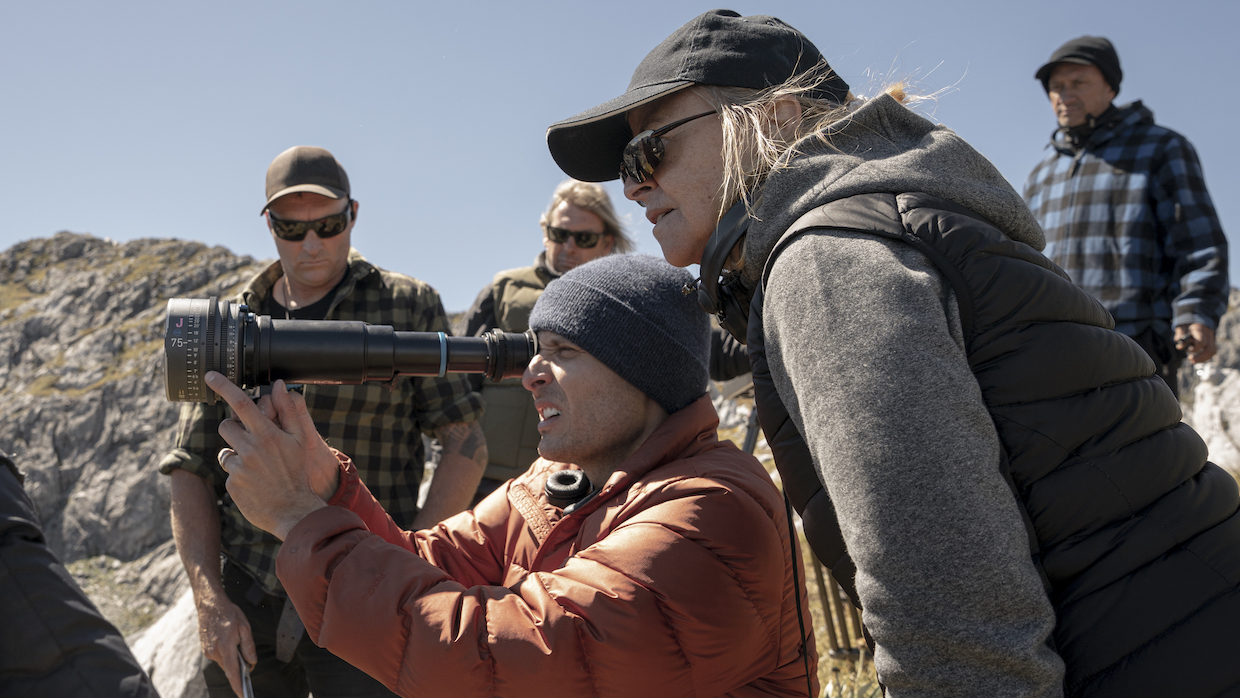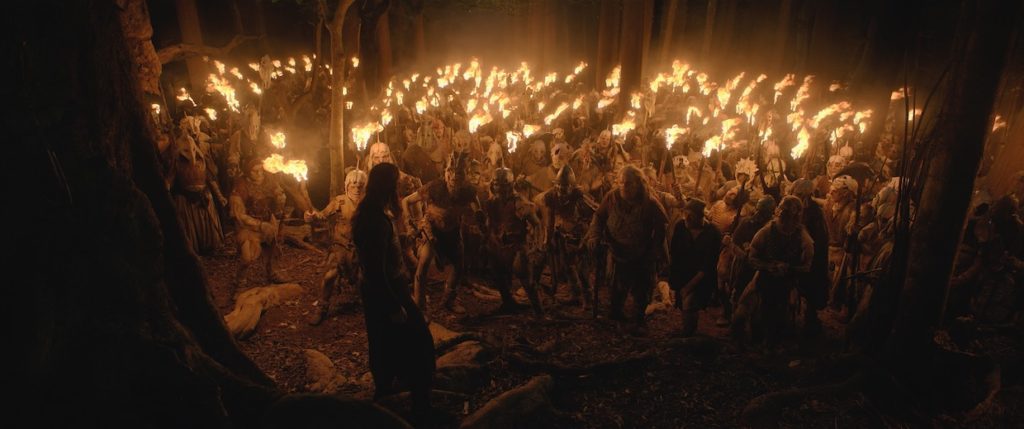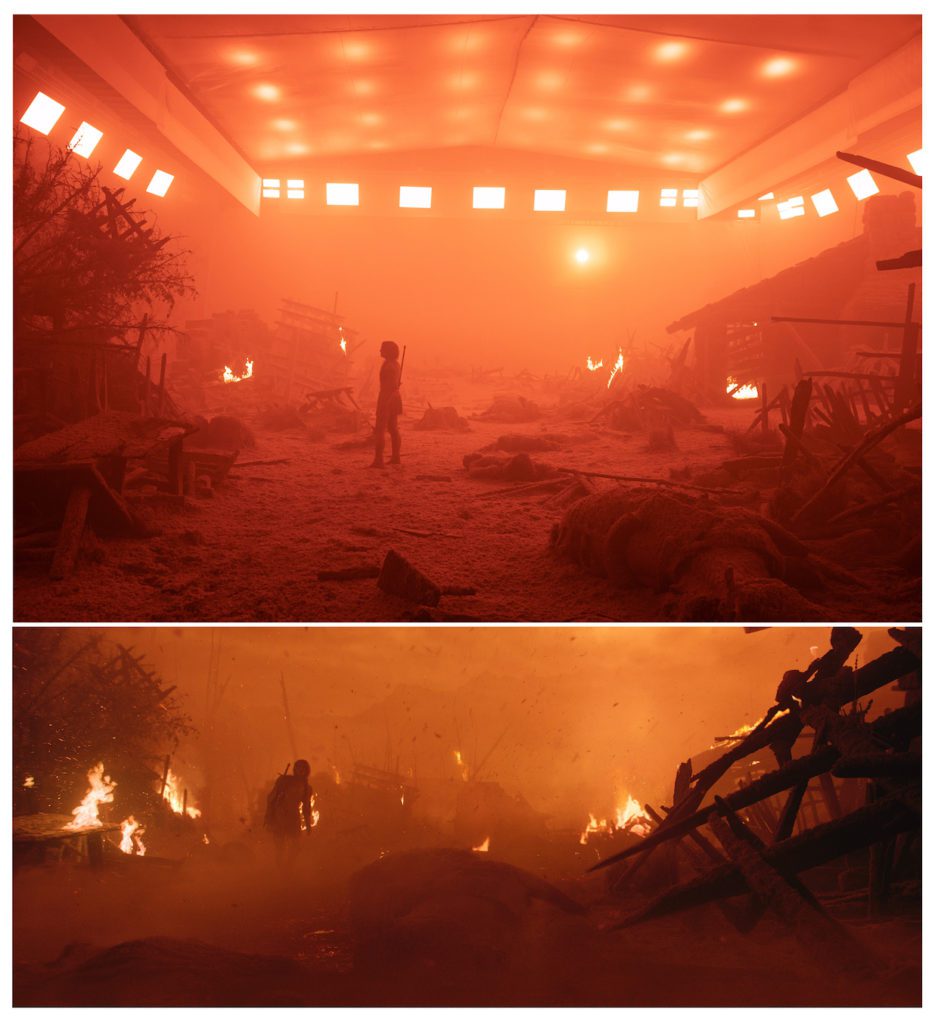 Back to selection
Back to selection
Shutter Angles
Conversations with DPs, directors and below-the-line crew by Matt Mulcahey
All Along the Parking Lot Watchtower: DP Alex Disenhof on The Rings of Power
 DP Alex Disenhof (with viewfinder) and director Charlotte Brändström on the set of The Rings of Power
DP Alex Disenhof (with viewfinder) and director Charlotte Brändström on the set of The Rings of Power Conventional wisdom says not to start with anything particularly difficult on the first few set ups of a new project. Start simple and let the crew acclimate to each other as they begin the process of finding the rhythm that will carry them through the long days and nights ahead. However, schedules don’t always allow you to ease into things. Sometimes, as cinematographer Alex Disenhof discovered on Amazon Studios’s The Rings of Power, you spend day one on a 14,000-foot mountaintop accessible only by helicopter.
“Our first two days of shooting were on Mount Kidd, which is on [New Zealand’s] South Island, and it was amazing,” said Disenhof. “That’s why you sign up for something like this—to have that kind of experience and be a part of that epic scale of filmmaking.”
The scale doesn’t get much more epic than The Rings of Power, reportedly the most expensive television show ever produced. Taking place during the Second Age of Middle-earth and based on the appendices of J.R.R. Tolkien’s climactic The Return of the King, the Amazon series serves as a prequel set thousands of years before Frodo and Sam journey to Mordor to plunge the One Ring into the fires of Mount Doom.
With the show now streaming on Amazon in its entirety, Disenhof spoke to Filmmaker about lensing episodes six and seven of the series.
Filmmaker: Let’s start with lenses. You used both Arri’s Signature Primes and Prime DNAs. What did you use each for?
Disenhof: We were on the Prime DNA LF lenses 95 percent of the time, then used the Signature Primes to round out the set on the longer end [of the focal lengths]. The DNA LFs only go to 135mm, so if we needed to go longer than that, we’d use the Signature Primes, [which go up to 280mm]. We did use Angenieux zooms for some shots as well, like when we were on the U-Crane arm shooting horses galloping. The lenses for the first season had been chosen already before I got there, but I had used the Prime DNAs on a show called The Mosquito Coast. I did the pilot and the first few episodes back in 2019, and that’s when I first fell in love with those lenses.
Filmmaker: The Rings of Power began filming in early 2020, then was shut down for about six months due to COVID. You didn’t actually shoot your episodes until over a year after that initial stretch of photography. Did that unusual schedule alter the way you worked with the team that shot the early episodes?
Disenhof: I actually had very little contact with the first group—honestly, I never spoke to them in person. The director, Charlotte Brändström, and I had been hired to do episodes six and seven. Unlike a lot of the other episodes, most of our work was shot on location, so it was a bit of a standalone thing. I made some tweaks and changes based on my own personal taste for certain lighting things—we wanted to make sure that people felt like it was the same show, but we certainly didn’t feel any pressure to keep everything exactly the same.
Filmmaker: What sets did you build?
Disenhof: The [watchtower of Ostirith] set was built in a parking lot.
Filmmaker: They actually built that tower?
Disenhof: The tower itself was a set extension, but the whole castle around it, up to about probably 40 feet up, was a real build. It was quite a large set. In terms of other proper sets, the [realm of the] dwarves and all the mines were built on stage. Our sets were spectacular. We really did as much in camera as you could possibly do. Everything you see, including the apocalyptic landscape that we did after the mountain explodes, there’s no bluescreen or greenscreen in that at all. That’s in camera with VFX embellishment. We had real fire. We created that color in camera with lighting and filters.
Filmmaker: What’s the process for creating a shot that is largely CG? For example, there’s a scene where Adar’s army is crossing the bridge to the watchtower of Ostirith. It’s a cloudy night exterior and the reflection of the army’s torches is seen in the water below the bridge. How do you build a shot like that?
Disenhof: That shot was thought up by myself and the director. We used Vcam [virtual cameras] on the show, which [allow you to explore] a virtual reality [replica] of your sets. So, I was able to fly around [those virtual sets] in a movie theater with a video game controller and see the landscape for this scene. I could pull the camera back to the angle of that wide shot and say, “This would be great if we could do a shot like this.” So, even though that castle set was built in a parking lot—so, obviously, we couldn’t actually do it practically—I was able to shoot it virtually, then hand that over and [the VFX team] could construct it with CGI. We did shoot a plate, though. We got the camera as far back as we could in the parking lot laterally to where the bridge would be and shot the Orcs coming across the bridge with their firelight. So, there is a practical element in there, but in that shot it’s very, very minimal.
Filmmaker: Was that the first time you’d used that tool?
Disenhof: Yeah, this was my first time. It was amazing. We actually used it to scout Mount Kidd as well. They flew over it with a helicopter and scanned it. So, I could [virtually] walk around the top of this mountain [with the Vcam]. We only got to fly there [in person] and scout it the day before we were going to shoot there, just because of the remoteness, so the Vcam was a very helpful tool. You can also ask the Vcam folks to change the settings, essentially, where it stops being in real time. It gives you a higher quality rendering and you can then play with lighting and get your lighting dialed in. For instance, if you have an idea for lighting a set and you say, “I’m not sure if it’s going to work,” you can go in there and work it out. It’s not an exact representation, but it will give you an idea whether your lighting concept will work or not.

Filmmaker: Your two episodes have multiple battles, and each gets its own rousing pre-clash speech. How do you plan coverage for those scenes where there’s a hundred extras, sometimes in extensive make-up? Do you have a few hero extras pre-selected for close-ups or do you find some of those shots on the day?
Disenhof: Charlotte and I really like to shotlist everything. We also storyboard certain scenes but [not] necessarily scenes like that, where it’s one person talking and a bunch of people listening. So, we shotlist, then when we get to set rehearse it with the actors, and that’s when you really find your angles. For instance, in Adar’s speech we found this tree that we loved, and we wanted to shoot the scene there. I knew where I wanted him to stand in front of the tree, and Charlotte wanted him to come from behind it and start small and intimate at the beginning of the episode. So, we had ideas about how we wanted to shoot it, then when we got on set with Joseph Mawle, the actor playing Adar, he was amenable to doing it the way we wanted, which was great. It ended up being very close to the idea in our heads. In terms of lighting that scene, like all of our night scenes with torches, I would actually light the scene first with just moonlight, which would be two to three stops underexposed. People could barely see anything on set [before the torches were brought in], but it was important, because I knew I wanted the torches to lead the lighting of the scene. Then, in the shadows you’d get just a tiny bit of cool blue [from the moonlight] that creates a nice color contrast.
For the [pre-battle speech by Arondir], it was all about sitting with the actors and figuring out the dynamic between them in the scene and how they wanted to project to the audience [of villagers]. We rehearsed it and saw things happen during that process. There’s a shot where we rack focus from an Orc head [on a spike] to Arondir. That was something where the art department just happened to put that head there and we said, “You know what, that’s an interesting shot.” So, things happen organically as well.
Filmmaker: In episode six, there’s a scene on the deck of Galadriel’s ship that takes place at dawn, then the sun rises. That seems like a challenge to pull off that lighting effect on a water tank stage.
Disenhof: I’m glad you brought that up. No one’s asked me about this yet, but that was one of the most challenging scenes. It ended up being a massive setup. The ship actually wasn’t in the tank for that shot. It was just on a gimbal. We were surrounded on three sides by gigantic storage container walls that we could make green, blue, black or white, depending on what the need was. We could skin them with different fabrics.
Filmmaker: Wait, you had the ship on the gimbal outside rather than on an interior soundstage?
Disenhof: Yes, that was shot outside. My challenge was, we had to shoot it during the day due to our schedule, and I needed to make sure that there was no direct sunlight on the set at all, because obviously that would ruin the look. I strung a massive silk over the whole thing, about 150 feet long by 50 or 60 feet wide. On top of that I had a black so the sun couldn’t hit the diffusion. For the dusk scenes, we had six or seven 18 Ks bouncing up into that overhead silk to create really soft ambience. Then, over the course of the scene, I slowly dimmed up a massive wall of tungsten lights behind our actors, bouncing against white to create this warm glow from the sun. The thing about a sunrise is that the actual atmosphere changes first. It’s not like all of a sudden a hard sun just blows into this soft blue world. It took an enormous amount of equipment to pull off. The set was three-sided in terms of the storage containers. So, I also had to close in the fourth side another way. We had like 18 Condors and Merlo cranes covering every square inch [of that open side] with big blacks.

Filmmaker: The warm orange glow of the light after the volcano erupts reminded me of two things—Roger Deakins’s work on Blade Runner 2049 and a 1990s Michael Bay/Bad Boys-esque tobacco filter look. The quality of light and color then changes as the characters get further away from the volcano.
Disenhof: For the scenes closest to the volcano, when we needed the heaviest amount of atmosphere and fire, we decided the best way to achieve that was having the control of a stage. I had this huge overhead and surrounding area of SkyPanels. We took three or four weeks of testing different colors until we found the tone we really thought represented the look we were after, which was inspired by the wildfires in California in 2018 and my own experience with some wildfires in Oregon in 2020. As the characters left that village and started to go away [from the volcano], I needed to make sure that I could bridge the look that we got on stage to this new look [that was shot on location]. It’s funny that you said tobacco filters, because that’s what I ended up using, then live graded it on set to match what we had on stage. So, at first, it’s a Tobacco 3 filter and heavy atmosphere and, as they get further into the woods, we used lighter grades of tobacco filters and lighter atmosphere.

Filmmaker: One of the most memorable bits of Peter Jackson’s Tolkien adaptations for me was the forced perspective work to create the height differential between different types of beings. You deal with that a little bit in your two episodes, particular between the elf Elrond and the dwarf Durin IV. How did you achieve that effect?
Disenhof: There was a lot of talk about how to do that. We ended up using a lot of motion control and shot a lot with the Technodolly. We did forced perspective when we could, but for a shot like [the one above], what we did was, we blocked the scene and our actor playing Elrond [Robert Aramayo] had a backpack on, with a stick with a picture of his head sticking above his own head to create the sense of height, so I knew how to frame the shot. We then rehearsed it with the actors and figured out the eyelines for each of them. When it was time to shoot, we removed Robert from the scene and the king, played by Peter Mullan, had a C Stand [as an eyeline], so he could look where he needed to look. Within that real space, we put greenscreen behind wherever Robert was going to move in the set, which was always a trick because you would try to backlight the scene to make it look a certain way, and when you have these small spaces you’re putting greenscreen sometimes only two or three feet behind [the actor] We would then scale down or up any camera moves depending on who was being shot. So, if we had to push in, for instance, it would be a certain amount of a push in for the king, but a different amount of push in for Robert. So, essentially, we’d shoot the scene with all the dwarfs, then shoot the scene just with Robert, then shoot a clean plate of the scene and put it all together.
